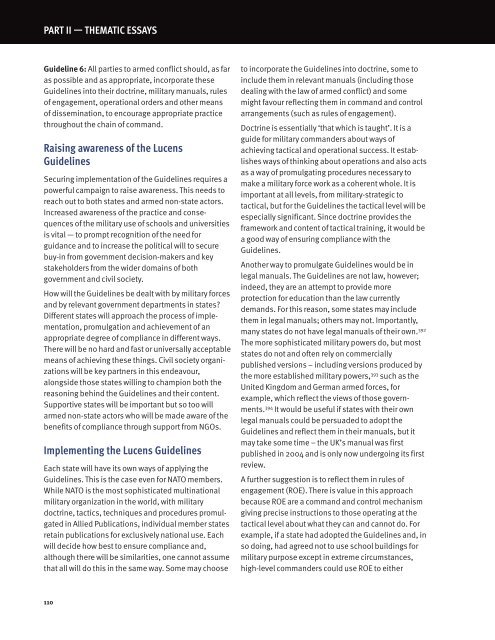You also want an ePaper? Increase the reach of your titles
YUMPU automatically turns print PDFs into web optimized ePapers that Google loves.
PART II — THeMATIC eSSAYSGuideline 6: All parties to armed conflict should, as faras possible and as appropriate, incorporate theseGuidelines into their doctrine, military manuals, rulesof engagement, operational orders and other meansof dissemination, to encourage appropriate practicethroughout the chain of command.Raising awareness of the LucensGuidelinesSecuring implementation of the Guidelines requires apowerful campaign to raise awareness. This needs toreach out to both states and armed non-state actors.Increased awareness of the practice and consequencesof the military use of schools and universitiesis vital — to prompt recognition of the need forguidance and to increase the political will to securebuy-in from government decision-makers and keystakeholders from the wider domains of bothgovernment and civil society.How will the Guidelines be dealt with by military forcesand by relevant government departments in states?Different states will approach the process of implementation,promulgation and achievement of anappropriate degree of compliance in different ways.There will be no hard and fast or universally acceptablemeans of achieving these things. Civil society organizationswill be key partners in this endeavour,alongside those states willing to champion both thereasoning behind the Guidelines and their content.Supportive states will be important but so too willarmed non-state actors who will be made aware of thebenefits of compliance through support from NGOs.Implementing the Lucens GuidelinesEach state will have its own ways of applying theGuidelines. This is the case even for NATO members.While NATO is the most sophisticated multinationalmilitary organization in the world, with militarydoctrine, tactics, techniques and procedures promulgatedin Allied Publications, individual member statesretain publications for exclusively national use. Eachwill decide how best to ensure compliance and,although there will be similarities, one cannot assumethat all will do this in the same way. Some may chooseto incorporate the Guidelines into doctrine, some toinclude them in relevant manuals (including thosedealing with the law of armed conflict) and somemight favour reflecting them in command and controlarrangements (such as rules of engagement).Doctrine is essentially ‘that which is taught’. It is aguide for military commanders about ways ofachieving tactical and operational success. It establishesways of thinking about operations and also actsas a way of promulgating procedures necessary tomake a military force work as a coherent whole. It isimportant at all levels, from military-strategic totactical, but for the Guidelines the tactical level will beespecially significant. Since doctrine provides theframework and content of tactical training, it would bea good way of ensuring compliance with theGuidelines.Another way to promulgate Guidelines would be inlegal manuals. The Guidelines are not law, however;indeed, they are an attempt to provide moreprotection for education than the law currentlydemands. For this reason, some states may includethem in legal manuals; others may not. Importantly,many states do not have legal manuals of their own. 392The more sophisticated military powers do, but moststates do not and often rely on commerciallypublished versions – including versions produced bythe more established military powers, 393 such as theUnited Kingdom and German armed forces, forexample, which reflect the views of those governments.394 It would be useful if states with their ownlegal manuals could be persuaded to adopt theGuidelines and reflect them in their manuals, but itmay take some time – the UK’s manual was firstpublished in 2004 and is only now undergoing its firstreview.A further suggestion is to reflect them in rules ofengagement (ROE). There is value in this approachbecause ROE are a command and control mechanismgiving precise instructions to those operating at thetactical level about what they can and cannot do. Forexample, if a state had adopted the Guidelines and, inso doing, had agreed not to use school buildings formilitary purpose except in extreme circumstances,high-level commanders could use ROE to either110



